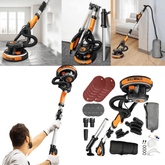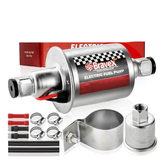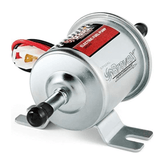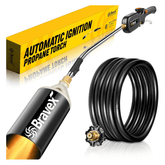Wet Sanding vs Dry Sanding: Which Should You Choose?
How can you achieve a flawless finish on any surface, like drywall, furniture, wood, or car? Wet sanding vs. dry sanding, which technique holds the key to perfection? In this article, we'll explore the differences between wet sanding and dry sanding, and uncover when to use each one. Are you ready to take your sanding skills to the next level? Let's delve into the world of smooth surfaces and find out which technique is right for you!

Wet Sanding vs Dry Sanding: What's the Difference?
Wet sanding and dry sanding are two distinct techniques used for achieving smooth surfaces, but they differ in several key aspects:
| Wet Sanding | Dry Sanding |
|---|---|
| Uses water as lubricant | No need for lubricant |
| Produces less dust | Generates a significant amount of dust |
| Super finer or polished finish | Smooth finish |
| Takes a more extensive amount of time | Takes less time |
| In straight-line motion | In circular motion |
| Done by hand only | Done by hand or power tools |
| Uses finer grit sandpaper | Uses coarser grit sandpaper |
1. Lubrication:
- Wet Sanding: Water is used as a lubricant during the sanding process to reduce friction and prevent overheating of the sandpaper. This lubrication allows for smoother sanding and helps to avoid damage to the surface being worked on.
- Dry Sanding: No additional lubrication is used, relying solely on the abrasive nature of the sandpaper to remove material. Dry sanding can generate more heat, which may increase the risk of damaging delicate surfaces if not done carefully.
2. Dust Production:
- Wet Sanding: The water used in wet sanding helps to minimize the production of airborne dust particles. The water captures the sanding residue, creating a slurry that settles rather than becoming airborne. This is particularly beneficial when working on surfaces that require dust control, such as automotive finishes or sensitive indoor environments.
- Dry Sanding: Dry sanding produces a significant amount of dust particles that become airborne during the process. Adequate dust control measures, such as using a 6.5-Amp Electric Drywall Sander 7 Variable Speed Floor Sander For Ceiling Wood and wearing respiratory protection, are necessary to minimize health risks and maintain a clean work area.
3. Surface Quality:
- Wet Sanding: The presence of water in wet sanding helps to smooth out the sanding marks more effectively, resulting in a finer finish. The water acts as a lubricant, reducing the chances of scratches or uneven sanding.
- Dry Sanding: Dry sanding can sometimes leave visible sanding marks on the surface, especially if not done carefully. However, it is often the preferred method of initial paint or finish removal, where achieving a perfectly smooth surface is not the primary objective.
4. Speed:
- Wet Sanding: Wet sanding can be much slower compared to dry sanding because you need to constantly rinse the sandpaper and your hands with water to keep the surface moist and prevent contamination. Additionally, cleaning the slurry is a requirement.
- Dry Sanding: Dry sanding tends to be faster since there is no need to manage water or deal with the slurry. It allows for quicker material removal and can be more efficient for tasks that require speed and productivity.
5. Safety:
- Wet Sanding: Wet sanding generally provides better safety in terms of reducing the risk of airborne dust particles. The water captures the particles, preventing them from being inhaled or settling on surrounding surfaces. However, precautions should still be taken to avoid slipping on wet surfaces and to protect electrical equipment from water damage.
- Dry Sanding: Dry sanding creates a significant amount of airborne dust, which can pose health risks if inhaled. However, so long as you protect yourself with goggles and a mask, and take dust control measures such as using a dustless power sander with a vacuum, you won't have to worry too much about dust causing health problems.
6. Application:
- Wet sanding: For wet sanding, you should use fine-grit sandpaper and sand in a straight-line motion, alternating directions with each pass. It can only be performed by hand, as power tools are not well-suited for this method.
- Dry sanding: Dry sanding can be done by hand or using a power sander. You will start with coarser sandpaper and then progress to finer grits for a smoother finish, sanding in a circular pattern.
Understanding these differences between wet sanding and dry sanding is essential in selecting the appropriate method for your specific project. Consider your desired finish, dust control requirements, and your comfort level with each technique to make the right decision.
Pros and Cons of Wet Sanding & Dry Sanding
Both wet sanding and dry sanding have their benefits and drawbacks. Let's take a closer look at the pros and cons of each method:
Wet Sanding
Pros:
- Less dust is produced.
- Smoother and mirror-like finish, achieving polish and minimizing sanding marks.
- Surface preservation, protecting delicate surfaces from damage.
Cons:
- More time-consuming, and requires continual water management, sandpaper rins, and slurry cleanup.
- Potential water damage to the surface and electrical malfunctions.
- Difficult progress assessment.
- Can be executed only by hand. (No power tool option)
Dry Sanding
Pros:
- Faster material removal.
- Time-saving.
- Hand or power sanders can be used for increased efficiency.
- More visible to access the progress.
Cons:
- Dust production, and health risks if inhaled.
Visible swirl marks or scratches if not done carefully.
Risk of delicate surface damage.
Wet Sanding vs. Dry Sanding: When to Choose
When deciding between wet sanding and dry sanding, it's important to consider your specific goals and the material surfaces involved.
Wet Sanding is the go-to option when you aim for a very smooth and polished finish, particularly on delicate surfaces and intricate work. It is perfect for tasks that require meticulous dust control and when you want to minimize the risk of surface damage. But note that wet sanding is more suited for projects where you can allocate time and effort to manage water and clean up the resulting slurry.
Wet Sanding is recommended for achieving a smooth and polished finish on the following materials:
- Automotive
- Wooden furniture
- Metal
- Tiles
On the other hand, dry Sanding is the preferred choice when efficiency and versatility are key. This method offers faster material removal and excels in various applications. It is well-suited for situations where you have proper dust control measures in place, such as using a power sand with a vacuum attachment and working in a well-ventilated area. Dry sanding is the way to go when you require clear progress visibility and are capable of handling the generated dust.
Opt for dry sanding when you want to sand the following materials:
- Drywall
- Bare wood
- Other rough materials and surfaces
However, the choice between wet sanding and dry sanding for a particular material is not always fixed. It is important to consider the specific characteristics of the material, such as its hardness and surface texture. Additionally, factors like the desired level of finish, the presence of existing coatings, and personal preference can also influence the choice.
Many people find that a combination of dry sanding followed by wet sanding produces excellent results. By carefully considering these factors, you can determine the most suitable sanding method for the material at your hand.
FAQs about Wet Sanding & Dry Sanding
Q1: Can wet sanding be done with power tools?
A: No, wet sanding is typically performed by hand because power tools are not commonly designed for wet sanding applications.
Q2: Does dry sanding create more dust than wet sanding?
A: Yes, dry sanding generates more airborne dust compared to wet sanding. It is important to take proper measures such as wearing a mask and using a power sander with dust collection.
Q3: Is there a way to dry sand a drywall without producing dust?
A: Yes, there are methods to minimize dust production during dry sanding. For a detailed guide, you can check out the guide on how to sand drywall without dust.
Q4: Does wet sanding require more skill compared to dry sanding?
A: Yes, wet sanding requires a certain level of skill and technique to maintain the right pressure, avoid over-sanding, and manage water and slurry effectively.
Q5: Can I switch between wet sanding and dry sanding during a project?
A: Yes, it's possible to switch between wet sanding and dry sanding techniques within a project, depending on the specific requirements of each stage. Just ensure that you adjust your tools and materials accordingly.
Q6: Are there any safety precautions to consider?
A: Both wet sanding and dry sanding require the use of appropriate personal protective equipment (PPE), such as safety glasses, masks, and gloves, to protect yourself from potential health hazards.
Q7: Can I use regular sandpaper for wet sanding?
A: No. You should use a special water-proof sandpaper that’s exclusively for wet sanding, such as wet sandpaper, and wet-dry sandpaper. Never use dry sandpaper for wet sanding.
Last Words
Choosing between wet sanding and dry sanding ultimately depends on the nature of your project, the desired outcome, and personal preference. Wet sanding excels in achieving a smooth finish on surfaces like automotive paint, while dry sanding is effective for initial paint removal. By understanding the strengths of each method and applying them correctly, you can elevate your sanding skills and achieve flawless results in your projects. So go ahead, grab your sandpaper, and let your creativity shine!








Leave a comment
Please note, comments need to be approved before they are published.